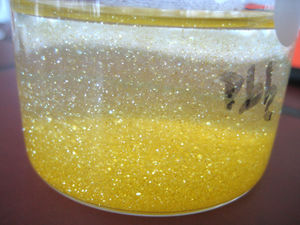Lead(II) iodide
 Some beautiful lead(II) iodide crystals
| |
| Names | |
|---|---|
| IUPAC name
Lead(II) iodide
| |
| Other names
Iodide yellow
Lead diiodide Plumbous iodide | |
| Properties | |
| PbI2 | |
| Molar mass | 461.01 g/mol |
| Appearance | Bright yellow solid |
| Odor | Odorless |
| Density | 6.16 g/cm3 (20 °C) |
| Melting point | 402 °C (756 °F; 675 K) |
| Boiling point | 953 °C (1,747 °F; 1,226 K) |
| 0.044 g/100 ml (0 °C) 0.0756 g/100 ml (20 °C) 0.41 g/100 ml (100 °C) | |
| Solubility | Insoluble in alcohols, hydrochloric acid, hydrocarbons |
| Vapor pressure | ~0 mmHg |
| Hazards | |
| Safety data sheet | Sigma-Aldrich |
| Flash point | Non-flammable |
| Related compounds | |
| Related compounds
|
Lead(II) chloride |
| Except where otherwise noted, data are given for materials in their standard state (at 25 °C [77 °F], 100 kPa). | |
| Infobox references | |
Lead(II) iodide or lead iodide is a salt with the formula PbI2.
Contents
Properties
Chemical
Lead(II) iodide is decomposed by light at moderately high temperatures.
In presence of air, lead iodide oxidizes to release free iodine.
- 2 PbI2 + O2 → 2 PbO + 2 I2
Physical
Lead(II) iodide is a bright yellow odorless crystalline solid, that becomes orange and red when heated. It is almost insoluble in water and insoluble in other solvents.
Lead iodide prepared from cold solutions of soluble lead and iodide salts usually consists of many small hexagonal platelets, giving the yellow precipitate a silky appearance. Larger crystals can be obtained by exploiting the fact that solubility of lead iodide in water (like those of lead chloride and lead bromide) increases dramatically with temperature. The compound is colorless when dissolved in hot water, but crystallizes on cooling as thin but visibly larger bright yellow flakes, that settle slowly through the liquid — a visual effect often described as "golden rain". Larger crystals can be obtained by autoclaving the PbI2 with water under pressure at 200 °C.
Even larger crystals can be obtained by slowing down the common reaction. A simple setup is to submerge two beakers containing the concentrated reactants in a larger container of water, taking care to avoid currents. As the two substances diffuse through the water and meet, they slowly react and deposit the iodide in the space between the beakers.
Availability
Lead(II) iodide is sold by chemical suppliers.
Preparation
Lead(II) iodide is commonly synthesized via a precipitation reaction between potassium iodide and a soluble lead salt, like lead(II) acetate or lead(II) nitrate in water solution:
- Pb(CH3COO)2 + 2 KI → PbI2 + 2 KCH3COO
- Pb(NO3)2 + 2 KI → PbI2 + 2 KNO3
This reaction is commonly used in demonstrations to show the precipitation reaction, since both precursors are colorless, while lead iodide is colored. The process is sometimes called "golden rain".
The compound can also be synthesized by reacting iodine vapor with molten lead between 500 and 700 °C.
Projects
- Golden rain experiment
- Make iodine yellow
- Compound collecting
Handling
Safety
Lead(II) iodide is very toxic to human health. Ingestion will cause many acute and chronic consequences characteristic of lead poisoning. Lead(II) iodide has been found to be a carcinogen in animals suggesting the same may hold true in humans. It is an inhalation hazard, appropriate respirator should be used when handling powders of lead iodide.
Storage
In closed bottles or ampoules.
Disposal
Should be taken to hazardous waste disposal centers.